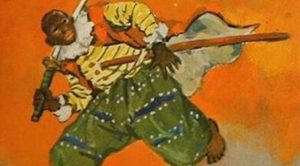When a 6-foot-tall African slave landed in Japan, he stuck out like a sore thumb. People lost all modesty and nearly caused a stampede trying to get a closer look. Such a sight was so foreign in Kyoto — he was one of the first Africans to ever arrive on the island — that a powerful Japanese warlord ordered him to remove his clothes while a flock of servants tried to scrub the “black ink” off his skin. Little did the warlord know that the slave was destined to become the world’s first Black samurai.
The samurai are among the most enduring symbols of Japanese cultural heritage, and few foreigners have ever claimed the title. But one unorthodox man stands out from the long lineup of noble Japanese warriors. The story of Yasuke may sound like the plot to a Quentin Tarantino movie, but he did indeed don a kabuto as history’s only African samurai. Yasuke was abducted from his home somewhere in central or western Africa — or Mozambique, historians say — and sold to a Jesuit priest named Alessandro Valignano. In 1579, Father Valignano went on a missionary trip to Japan and took Yasuke with him. According to letters of Portuguese missionary Luis Frois and The History of the Church of Japan, a 17th-century book by François Solier, Yasuke was around 24 or 25 years old, towered over the Japanese at 6-foot-2 and had skin like an “ox” or “charcoal.”
His celebrity status soon piqued the curiosity of Oda Nobunaga, a medieval Japanese warlord who was striving to unify Japan and bring peace to a country racked by civil war. Nobunaga praised Yasuke’s strength and stature, describing “his might as that of 10 men,” and brought him on as his feudal bodyguard. The African’s original name is unknown, but Nobunaga called him Yasuke, most likely a Japanization of his birth name or Christian name. A worldly and open-minded ruler, “Nobunaga was very meritocratic. He could see past the skin. He used the Portuguese and foreigners during that time to his advantage,” says Lawrence Winkler, author of Samurai Road.
read more here
Ask me anything
Explore related questions





